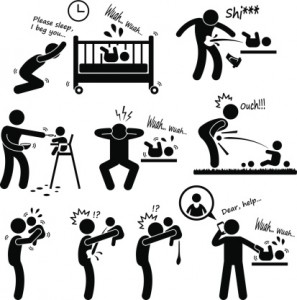
Pregnant moms often ask about what they need to do to get ready to breastfeed once their baby arrives. While there is no cookie-cutter approach or check-list of To-Dos that will guarantee a satisfying experience with breastfeeding, taking measures before baby arrives to learn about breastfeeding and to line up a network of support can make for more positive outcomes. And while every family’s situation and available resources are unique, we’ve composed the following check list as a general guideline to help families get off on the right foot.
10. Learn about breastfeeding! Take a class, read a book or two and ask LOTS of questions. It’s been our experience that many women will spend months researching and learning about childbirth but barely a fraction of that time learning about breastfeeding. Breastfeeding may be the most natural way to feed your baby, but for many women it’s a bodily art that doesn’t always come easily or naturally. Learning about the process before you enter into it will allow you to ask informed questions as your work your way through it.
 9. Check to see what lactation services your insurance provider routinely covers. Will they cover a breastfeeding class? How about a consultation with an IBCLC (International Board Certified Lactation Consultant)? Most cover a basic double electric breast pump since the enactment of the Affordable Care Act, but what if your baby has special needs, you have twins, or a baby in the NICU? What if you need a hospital grade multiple-user pump? Call the customer care number on the back of your insurance member ID card and ask these questions. Ask for specifics, like, “Will you cover a lactation consultation office visit? How about a home visit? What credentials do you require of the service provider?” Be sure to get the name of the customer service representative and a reference number for your phone call. When it comes to pumps, you likely will be covered for something. Our LCs can help you navigate the process (see more about this in our blog article: Are You Getting the Best Breast Pump From Your DME for Your ACA Benefit? ). We can help determine your eligibility, set you up with a pump and provide ongoing phone support for questions related to breastfeeding, pumping and maintaining your supply. The service is free. You can submit your info through our secure site at: Lactation Care’s Insurance Pump Portal.
9. Check to see what lactation services your insurance provider routinely covers. Will they cover a breastfeeding class? How about a consultation with an IBCLC (International Board Certified Lactation Consultant)? Most cover a basic double electric breast pump since the enactment of the Affordable Care Act, but what if your baby has special needs, you have twins, or a baby in the NICU? What if you need a hospital grade multiple-user pump? Call the customer care number on the back of your insurance member ID card and ask these questions. Ask for specifics, like, “Will you cover a lactation consultation office visit? How about a home visit? What credentials do you require of the service provider?” Be sure to get the name of the customer service representative and a reference number for your phone call. When it comes to pumps, you likely will be covered for something. Our LCs can help you navigate the process (see more about this in our blog article: Are You Getting the Best Breast Pump From Your DME for Your ACA Benefit? ). We can help determine your eligibility, set you up with a pump and provide ongoing phone support for questions related to breastfeeding, pumping and maintaining your supply. The service is free. You can submit your info through our secure site at: Lactation Care’s Insurance Pump Portal.
8. Talk to your CNM (Certified Nurse Midwife) or Ob/Gyn about your breasts and nipples. Go on, check them out! Before baby arrives can be a better time to discuss those nipple piercings you had in college (or still have) or that needle biopsy or that breast reduction surgery you had. Are your nipples flat or inverted? Have you experienced breast changes during your pregnancy? Not sure? Ask your healthcare provider for an evaluation of your breasts and nipples. Shine a light on your ladies. Gaining info now will allow you the time you may need to line up additional lactation support should your provider think if may be beneficial for you.
7. Talk to your CNM or Ob/Gyn about a birthing plan that is supportive of breastfeeding. Discuss your options for rooming-in with baby and avoiding or postponing interventions that may interfere with early breastfeeding. Plan to have this talk around the 32nd week of your pregnancy because sometimes babies arrive unexpectedly early and this conversation is important.

6. Before baby arrives, establish a connection with a lactation consultant. Look for the credential “IBCLC” which denotes the highest level of accreditation within the field. Not sure where to find one? Ask your CNM or Ob/Gyn or Pediatrician for a recommendation. Have friends or families had a positive experience with a particular practitioner? Other great resources for finding an LC are:
- Zipmilk: a site managed by the Massachusetts Breastfeeding Coalition, just type in your zipcode!
- The International Lactation Consultant Association
- The United States Lactation Consultant Association
5. Bookmark useful sites for evidence-based information pertaining to breastfeeding. Consider the following as great resources for breastfeeding information:
- Breastfeeding Online Lactation expert Dr. Jack Newman’s amazing library of breastfeeding info
- Kellymom for fantastic info regarding breastfeeding and parenting
- Normal Fed Diana Weissinger, MS, IBCLC discusses the normalcy of breastfeeding for our species
- LactMed a database published by the National Institutes of Health regarding medications and lactation. Heck, they even have an app you can download to your phone, just like…
- Medications and Mother’s Milk a similar database about medications during pregnancy and lactation and published by Dr. Thomas Hale. And, yeah, they’ve got an app for that too.
4. Spend a day with a breastfeeding family. You may have fairly romantic ideas of what life with a baby may be like. A day in the trenches of full-frontal breastfeeding and baby-care reality just might shift your thinking back toward reality. Believe it or not, you will be very, VERY busy. New motherhood is NOT a good time to A) Move to a new home, B) Finish your Master’s Degree, or C) Embark on a home-based business. Baby-care is a 24/7 endeavor and having realistic expectations about what your day-to-day life will be like can make the adjustment period go a bit more smoothly.
3. Talk to your partner/spouse/support people, really anyone who will be involved in your child’s care, about how important breastfeeding is to you. While you will be actively engaged in mothering your little one and feeding at the breast, you will need them to support you and help out with everything else! Many “helpers” are at a loss when they can’t help with feedings and may beg and plead for the opportunity to give your nursling a bottle. And while well-intentioned, such “help” could actually undermine your breastfeeding experience. Offer alternatives and prepare a list of to-dos that they can assist with. For example, assign them with laundry duty, food preparation and clean up, running errands, snow removal, yard work, and toilet bowl scrubbing! You mother the baby and everyone else mothers you. No task is too menial, dirty or demeaning to delegate. Go on, ask your father-in-law to clean up those cat hairballs from behind the toilet! Make a list of everything that will be difficult for you to manage with one hand juggling a squirmy baby and you pretty much have a good idea of what you’ll need help with.
2. Set a goal for breastfeeding for yourself and your baby. Avoid deciding to “just give it a try.” Set a goal and stick to your guns. Breastfeeding success is often dictated by 1. Determination, and 2. Support. If you’re not sure what to expect or what is even normal then consider committing to providing your baby with your colostrum during the first few days. For some mothers taking each day one day at a time and re-evaluating the feeding plan as the process unfolds can help to make the feel more manageable and sustainable. Trust that you are the best judge of what plan is going to work for you and your family. A professional lactation consultant is someone you can lean on throughout your process, including if and when you decide to bring an end to breastfeeding. They can provide you with options in a non-judgmental way and support you to bring breastfeeding to an end in a manner that will be healthy for you and for baby.
 1. Plan to bring baby to breast as soon as possible after birth. Practice frequent opportunities for skin to skin contact to take advantage of your baby’s innate programming to feed at the breast. The benefits of skin to skin contact for all babies have been well documented for over 30 years. All babies need skin to skin contact and babies who receive skin to skin breastfeed better and longer. In addition to facilitating breastfeeding, skin to skin helps babies to cry less, stay warmer and calmer and maintain blood sugar levels. It’s a no-brainer and the first step to getting off to the best start with breastfeeding.
1. Plan to bring baby to breast as soon as possible after birth. Practice frequent opportunities for skin to skin contact to take advantage of your baby’s innate programming to feed at the breast. The benefits of skin to skin contact for all babies have been well documented for over 30 years. All babies need skin to skin contact and babies who receive skin to skin breastfeed better and longer. In addition to facilitating breastfeeding, skin to skin helps babies to cry less, stay warmer and calmer and maintain blood sugar levels. It’s a no-brainer and the first step to getting off to the best start with breastfeeding.

